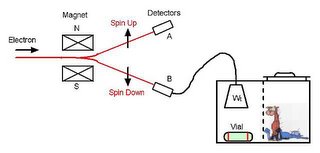Bạn thử nghĩ xem mệnh đề sau đây đúng hay sai:
(biết rằng "tôi còn sống" = ¬"tôi đã chết")
Chắc hẳn là nó phải Sai, đúng không nào?!
Nhưng bạn thử nghĩ lại một lần nữa xem, có thay đổi quyết định không? ;-)
.
.
.
Bây giờ chúng ta thử dùng lô-gíc hình thức để xem xét nhé.
Đặt
P = "Nếu tôi còn sống thì tôi đã chết"
Q = "Tôi còn sống"
Vì
"tôi còn sống" = ¬"tôi đã chết"
Nên
P = Q → ¬Q
Dùng công thức
A→B = ¬A ∨ B
Ta có
P = Q → ¬Q
= ¬Q ∨ ¬Q
= ¬Q
Kết luận
P = ¬Q
= "tôi đã chết"
Vậy mệnh đề này không (hằng)đúng mà cũng không (hằng)sai, nó tương đương với mệnh đề con đơn giản hơn là "tôi đã chết".
Nếu bạn muốn "chơi khăm", có thể làm cho mệnh đề khó hơn bằng cách kéo dài nó ra thành:
"Mệnh đề 'Nếu tôi còn sống thì tôi đã chết' mà sai, thì tôi chết mất!"
(biết rằng "tôi còn sống" = ¬"tôi đã chết" = ¬"tôi chết mất")
Dùng lô-gíc hình thức phân tích thì ta thấy mệnh đề này có dạng:
R = ¬(Q→¬Q) → ¬Q
= Q → ¬Q
= ¬Q
Và theo lý thuyết, bạn có thể kéo dài ra mãi!
Liên tưởng tới Vật lý Lượng tử, ta có thể thấy nó có liên quan đến còn mèo "dở sống dở chết" của Schrödinger(Schrödinger's cat).

Hoặc nghĩ về Lý thuyết Tính trong Tin học, thì ta nhận ra ngay lớp bài toán "không giải được"(bài toán "dừng") nổi tiếng(Halting problem). Tính "không giải được" được chứng minh nhờ luận đề Turing-Church(Turing-Church thesis).
Còn bây giờ thì mình bỗng nhớ lại một bài toán lô-gíc hấp dẫn mà mình đã được học từ hơn chục năm trước (hình như là hồi lớp 5), bài "Treo cổ - Chặt đầu":
Ngày xửa ngày xưa, ở một vương quốc nọ, có một ông vua độc ác cai trị nhân dân một cách tàn nhẫn và bất công khiến cho nhiều người trong nước đó cứ lũ lượt kéo nhau bỏ sang nước khác hết... Thế là ông vua ấy mới ban hành một điều luật thật quái đản vô nhân đạo rằng: "Ai muốn ra ngoài biên giới thì phải nói một câu. Nếu câu ấy Đúng thì sẽ bị Chặt đầu. Còn nếu câu ấy Sai thì sẽ bị Treo cổ." Từ đó, chẳng còn ái dám bén mảng ra ngoài biên giới nữa.
Ông ta tưởng như thế là đã thành công rồi! Nhưng nào ngờ, một ngày kia, có một nhà thông thái vẫn cứ ung dung bước chân ra vùng biên giới.... Lính gác gặp nhà thông thái thì chặn lại bảo: "Ông già ngạo mạn kia, hãy nói một câu xem nào". --Tới đây, hỡi các nhà thông thái của chúng ta hãy thử nghĩ xem nên nói câu gì nào? :-?-- .............Nhà thông thái không chùn bước, vừa đi vừa nói: "Ta sẽ bị treo cổ!"... Thế là lính gác cùng các quan binh đều phải để cho ông đi. Đem câu đó tâu lên vua, cả triều đình cũng phải... bó tay! :-))